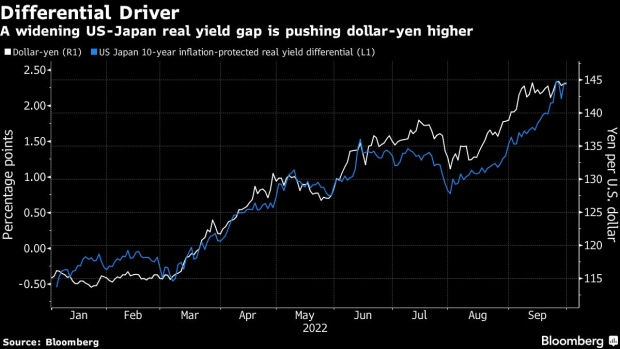Sep 30, 2022
Japan Spent $19.7 Billion in September Forex Market Intervention
, Bloomberg News

(Bloomberg) -- Japan spent a likely record daily amount to prop up the yen last week, leaving economists and investors wondering how many times the government could intervene again despite skepticism over the impact of such action.
The Ministry of Finance disclosed Friday that it spent 2.84 trillion yen ($19.7 billion) in September to slow the yen’s slide in its first intervention to support the currency since 1998. Some private analysts had estimated the intervention at up to 3.6 trillion yen.
The widely held view among market participants and economists is that the intervention only took place on Sept. 22 after the Bank of Japan’s stand-pat decision, though the data cover the whole month.
More specific details on daily intervention in September and the currency pairs involved will be announced in early November.
Despite an initial gain of more than 3.5% in the yen against the dollar, the surprise move hasn’t reversed the currency’s weakening trend amid a continued strengthening of the greenback. Volatility remains high in edgy global financial markets with the pound’s recent heavy slide adding to the jitters.
Japan still has scope for more buying of the currency, but its foreign currency reserves are not limitless. With the Federal Reserve set to keep raising borrowing costs while the Bank of Japan sticks with rock-bottom rates, the country needs to stay realistic about what it can do, analysts say.
“While spending a record amount to prop up the yen for a day shows the strength of their resolve, the ministry is also being careful not to use too many of its reserves at the start of this long battle,” said Takeshi Minami, chief economist at Norinchukin Research Institute, commenting on the smaller-than-expected amount.
“Even a basic calculation shows the ministry can do the same scale of intervention several times more,” he added.
What Bloomberg Economics Says...
“Japan’s FX intervention may work on a very limited basis as a time-buying strategy until a slowing US economy causes the Fed to reverse course.”
-- Yuki Masujima, economist
The yen was around 144.44 per dollar early Friday evening in Tokyo, compared with 140.36 after last week’s intervention by the BOJ on behalf of the finance ministry.
Japan’s Finance Minister Shunichi Suzuki has made clear the nation is ready to act again against excessive speculative moves. His right-hand man Masato Kanda has indicated that Japan is on guard against sharp moves in the currency rather than looking to defend a specific currency level such as 145.
Japan has about $1.29 trillion dollars worth of foreign reserves as of August, according to the ministry. Among its most liquid foreign reserve assets are deposits amounting to $136.1 billion with foreign central banks and the Bank for International Settlements. Beyond those, Japan might have to sell some of its holdings of US Treasuries.
The government may be able to execute four to 10 similar interventions by selling liquid assets, depending on whether it uses only the deposits or also draws on securities shorter than one year in maturity, according to Bank of America strategists.
Still, it’s not clear that intervening 10 times would be effective in a prolonged battle, with each attempt likely to see diminishing returns.
BOJ Governor Haruhiko Kuroda once again made it crystal clear last week that he won’t raise rates for a long while as he seeks stable inflation. That’s a stance that will keep downward pressure on the yen, even after it has shed around 20% this year.
Kuroda’s comments, within hours of the Fed pointing to a higher rate path, sent the yen to a fresh 24-year low of 145.90 before the intervention.
Japan stepped in six times to support the yen between December 1997 and June 1998, with its biggest splurge of 2.6 trillion yen coming on April 10. Ultimately the tide against the currency didn’t start to turn until Japan took joint intervention with the US that year.
The US said it understood Japan’s move last week, but didn’t offer a resounding show of support. With the fight against inflation taking central stage there, helping Tokyo deal with a currency partly weakened by the BOJ’s own monetary policy seems unlikely.
Some analysts also say Japan selling Treasuries to fund intervention may trigger friction with the US. Such action could push up US yields and further widen the rate differential with Japan, adding to downward pressure on the yen in a boomerang effect, they say.
“It’s unlikely they are going to get support from the US or others for intervention so they’ll have to battle on alone,” Minami said. “The key is how effectively they are going to use their ammunition. Timing is very important and it’s going to be no surprise if the yen hits 150.”
The dollar moved just over 2 yen from the day before the BOJ decision to the afternoon of the intervention. If Japan cites the damaging impact of volatility again to justify its actions within the bounds of Group of Seven agreements, a similar or larger move is likely needed to justify another splurge.
“Japan will probably intervene again if the yen moves 2 or 3 yen in a day,” said Masafumi Yamamoto, chief currency strategist at Mizuho Securities in Tokyo. “The finance ministry is ready to step in.”
(Adds economist comments)
©2022 Bloomberg L.P.






